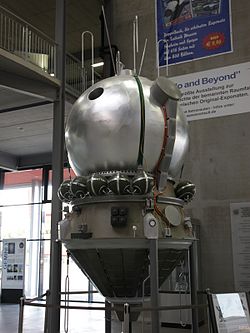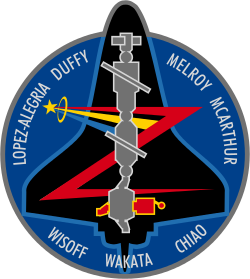STS-106
| STS-106 | |||||
 | |||||
| Uppdrag | 99 | ||||
|---|---|---|---|---|---|
| Rymdfärja | Atlantis (22)[1] | ||||
| NSSDC-ID | 2000-053A[2] | ||||
| Färdens tid | 11 dagar, 19 timmar, 12 minuter, 15 sekunder | ||||
| Uppskjutning | |||||
| Startplats | Startplatta 39B vid Kennedy Space Center i Florida | ||||
| Start | 8 september 2000, 12:45:47 UTC | ||||
| Landning | |||||
| Landningsplats | KSC, Runway 15 | ||||
| Landning | 19 september 2000, 07:56 UTC | ||||
| Omloppsbana | |||||
| Varv | 185 st[3] | ||||
| Apogeum | 325 km | ||||
| Perigeum | 159 km | ||||
| Banlutning | 51,6° | ||||
| Sträcka | 7,900 miljoner km | ||||
| Rymdpromenad | |||||
| Antal | 1 st | ||||
| Total tid | 6 timmar, 14 minuter | ||||
| Dockning | |||||
| Rymdstation | ISS | ||||
| Dockning | 10 september 2000, 05:51:25 UTC | ||||
| Dockningsport | PMA-2 (Unity, fram) | ||||
| Urdockning | 18 september 2000, 03:46 UTC | ||||
| Tid dockad | 7 dagar, 21 timmar, 54 minuter, 35 sekunder | ||||
| Besättning | |||||
| Befälhavare | Terrence W. Wilcutt (4) | ||||
| Pilot | Scott Altman (2) | ||||
| Uppdragsspecialister | Daniel C. Burbank (1) Edward T. Lu (2) Richard A. Mastracchio (1) Jurij Malentjenko (2) Ryssland Boris Morukov (1) Ryssland | ||||
 | |||||
| Kronologi Rymdfärjeprogrammet | |||||
| |||||
STS-106 var en flygning i det amerikanska rymdfärjeprogrammet med rymdfärjan Atlantis till Internationella rymdstationen, ISS. Den sköts upp från Pad 39B vid Kennedy Space Center i Florida den 8 september 2000. Efter nästan tolv dagar i omloppsbana runt jorden återinträdde rymdfärjan i jordens atmosfär och landade vid Kennedy Space Center.
Flygningens mål var att leverera utrustning och förnödenheter till rymdstationen, detta gjorde man med hjälp av en Spacehab-modul placerad i rymdfärjans lastrum.
Rymdpromenad
Under flygningens enda rymdpromenad fästes kablar för att fullt ut integrera Zvezda-modulen till resten av ISS.
Man konstruerade och fäste även en magnetometer som ett back-up-navigationssystem för rymdstationen.[4]
Statistik
| 1. | 11 september 2000 04:47 UTC | 11 september 2000 11:01 UTC | 6 tim, 14 min |
Besättning
- Terrence W. Wilcutt (4), befälhavare
- Scott Altman (2), pilot
- Daniel C. Burbank (1), uppdragsspecialist
- Edward T. Lu (2), uppdragsspecialist
- Richard A. Mastracchio (1), uppdragsspecialist
- Jurij Malentjenko (2), uppdragsspecialist
- Boris Morukov (1), uppdragsspecialist
Se även
Referenser
- ^ NASA Space Shuttle Launch Archive Arkiverad 13 augusti 2010 hämtat från the Wayback Machine., läst 28 juli 2016.
- ^ ”NASA Space Science Data Coordinated Archive” (på engelska). NASA. https://nssdc.gsfc.nasa.gov/nmc/spacecraft/display.action?id=2000-053A. Läst 22 mars 2020.
- ^ Manned Astronautics - Figures & Facts Arkiverad 4 mars 2016 hämtat från the Wayback Machine., läst 28 juli 2016.
- ^ NASA (2000). ”STS-106 Day 3 Highlights”. NASA. Arkiverad från originalet den 17 september 2008. https://web.archive.org/web/20080917080812/http://science.ksc.nasa.gov/shuttle/missions/sts-106/sts-106-day-03-highlights.html. Läst 6 oktober 2008.
Externa länkar
 Wikimedia Commons har media som rör STS-106.
Wikimedia Commons har media som rör STS-106.
| ||||||||
| |||||||||||||||||||||||||||||||
| ||||||||||||||||||||||||||||||||
Media som används på denna webbplats
Rotated and color enhanced version of original (ISS013-E-48788 (6 July 2006) --- The Space Shuttle Discovery approaches the International Space Station for docking but before the link-up occurred, the orbiter went through a series of inspection photos by station crew to inspect the vehicle for any damage to its Thermal Protection System. This was known as the Rendezvous Pitch Maneuver and was implemented after the Columbia Disaster in 2003. The Leonardo Multipurpose Logistics Module can be seen in the shuttle's cargo bay. Discovery docked at the station's Pressurized Mating Adapter 2 at 9:52 a.m. CDT, July 6, 2006.)
Backdropped by a blue and white Earth, this close-up view features the Soyuz TMA-6 spacecraft approaching the International Space Station (ISS). Onboard the spacecraft are cosmonaut Sergei K. Krikalev, Expedition 11 commander representing Russia's Federal Space Agency; astronaut John L. Phillips, NASA ISS science officer and flight engineer; and European Space Agency (ESA) astronaut Roberto Vittori of Italy. The Soyuz linked to the Pirs Docking Compartment at 9:20 p.m. (CDT) on April 16, 2005 as the two spacecraft flew over eastern Asia. The docking followed Friday’s launch from the Baikonur Cosmodrome in Kazakhstan.
In this illustration, a SpaceX Crew Dragon spacecraft approaches the International Space Station for docking. NASA is partnering with Boeing and SpaceX to build a new generation of human-rated spacecraft capable of taking astronauts to the station and expanding research opportunities in orbit. SpaceX's upcoming Demo-1 flight test is part of NASA’s Commercial Crew Transportation Capability contract with the goal of returning human spaceflight launch capabilities to the United States.
Författare/Upphovsman: Pascal (Flickr user: pasukaru76), Licens: CC0
Vostok spacecraft replica at the Technik Museum Speyer, Germany.
STS106-S-0002 (June 2000): Five NASA astronauts and two cosmonauts representing the Russian Aviation and Space Agency take a break in training from their scheduled September 2000 visit to the International Space Station. Astronauts Terrence W. Wilcutt (right front) and Scott D. Altman (left front) are mission commander and pilot, respectively, for the mission. On the back row are the mission specialists. They are (from left) cosmonaut Boris V. Morukov, along with astronauts Richard A. Mastracchio, Edward T. Lu and Daniel C. Burbank and cosmonaut Yuri I. Malenchenko. Morukov and Malenchenko represent the Russian Aviation and Space Agency.
The STS-101 mission patch commemorates the third Space Shuttle flight supporting the assembly of the International Space Station (ISS). This flight's primary tasks are to outfit the ISS and extend its lifetime, and to conduct a spacewalk to install external components in preparation for the docking of the Russian Service Module, Zvezda, and the arrival of the first ISS crew. The Space Shuttle is depicted in an orbit configuration prior to docking with the ISS. The ISS is depicted in the stage of assembly completed for the STS-101 mission, which consists of the United States-built Unity module and the Russian-built Zarya module. The three large stars represent the third ISS mission in the assembly sequence. The elements and colors of the border reflect the flags of the nations represented by the STS-101 crew members, the United States and Russia. The NASA insignia design for Shuttle flights is reserved for use by the astronauts and for other official use as the NASA Administrator may authorize. Public availability has been approved only in the form of illustrations by the various news media. When and if there is any change in this policy, which is not anticipated, it will be publicly announced.
Designed by the crew members, the STS-92 patch symbolizes the second mission to carry U.S.-built elements to the International Space Station (ISS) for assembly. The black silhouette of the Space Shuttle Discovery stands out against the deep blue background of space in low Earth orbit. In the foreground in gray is a profile view of the ISS as it appears when the shuttle and crew arrive, with the station consisting of the Unity node, its two pressurized mating adapters (PMA), the Zarya functional cargo block, the Zvezda service module, and the Progress cargo vehicle.
Following the shuttle's rendezvous and docking, the ISS configuration will be augmented by the two elements delivered by Discovery–the Z1 truss and PMA-3. These two elements, depicted in red, will be installed using the shuttle's robot arm and be connected to ISS during four spacewalks. The multi-national nature of both the STS-92 crew and the ISS are reflected in the multi-colored Astronaut Office symbol.
This is the crew patch for the STS-106 mission, which is the first Shuttle flight to the International Space Station since the arrival of its newest component, the Russian-supplied Service Module Zvezda (Russian for star). Zvezda is depicted on the crew patch mated with the already orbiting Node 1 Unity module and Russian-built Functional Cargo Block, called Zarya (sunrise), with a Progress supply vehicle docked to the rear of the Station. The International Space Station is shown in orbit with Earth above as it appears from the perspective of space. The Astronaut Office symbol, a star with three rays of light, provides a connection between the Space Shuttle Atlantis and the Space Station, much the same as the Space Shuttle Program is linked to the International Space Station during its construction and future research operations. Stylized versions of flags from Russia and the United States meet at the Space Station. They symbolize both the cooperation and joint efforts of the two countries during the development and deployment of the permanent outpost in space as well as the close relationship of the American and Russian crew members.












